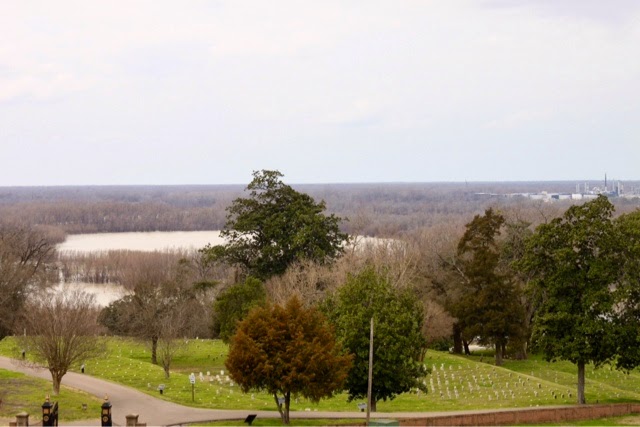Battery De Golyer, from this position a battery of guns bombarded the Confederate Great Redoubt.
Shirley House, the only surviving wartime structure.
Illinois Memorial
Looking out over the Vicksburg Battlefield. Red Confederate and blue Union (Federal) markers cover the battlefield so that at a glance you can see where troops were stationed.
Wisconsin Memorial
Ransom's Gun Path, men of the 2nd Illinois Artillery dismantled two 12-pounder cannons and dragged the guns over rough terrain to the top of an earthen parapet just 100 yards from the Confederate position.
The guns were reassembled and returned to action.
Thayer's Approach, the visible trench was dug by Union troops to access the top of this hill while under fire. The men covered the trench with brush to remain undetected. Confederate troops knew they were there but the sharpshooters couldn't stop their advancement.
View of the Mississippi River from the USS Cairo.
Vicksburg National Cementery is the largest burial site of Civil War Union soldiers and sailors. Over 17,000 are buried here; almost 13,000 are unknown.
View of the Mississippi River from the battlefield. President Lincoln knew the key to winning the war was to control the river and divide the south.
USS Cairo
The USS Cairo Gunboat was sunk by a Confederate torpedo (mine) on December 12, 1862 in the Yazoo River, 13 miles from Vicksburg. It was located and identified in1956 and raised on December 12, 1964.
US Navy Memorial
13 Cannon were on board the ironclad gunboat.
Steam powered paddle wheel.
Capstan, this powerful winch was used to haul heavy lines, move the guns on deck, and pull in the anchor. It was steam powered but could be powered manually in an emergency.
Restored firebox door. Coal shoveled into the fireboxes heated the boilers; steam from the boilers powered the Cairo's engines and her paddle wheel.
The USS Cairo was one of seven ironclads built in 100 days for the Union.
The iron on the bow of the Cairo looks like railroad tracks.
The wooden hull survived in the mud of the Yazoo River along with information on naval construction, naval stores, armament, and the crew's personal gear. Many of these things are on display in the USS Cairo Museum.
Compare the officers' tableware to that of a sailor.
Cross cut wooden museum floor.
Here you can see by the blue Federal and red Confederate signs how close they were in battle. The 1863 surrender of Vicksburg, along with the defeat of General Robert E. Lee's army at Gettysburg, marked a turning point in the Civil War. Fighting continued for 21 more months but Federal control of the Mississippi River insured the survival of the Union.

































No comments:
Post a Comment